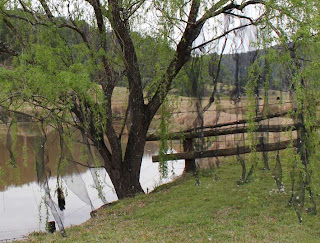Taking home the Japan Foundation New Artist Award for 2010, Kath Fries of NSW has been announced as the First Prize winner of this year’s facetnate! program, an initiative by the Japan Foundation, Sydney, designed to support emerging visual artists.
Facetnate's Head Judge, John McDonald, Chief Art Critic of The Sydney Morning Herald, selected the overall winning exhibition from the three finalist entries.
Fries' successful exhibition Grove, was inspired by the centuries-old Japanese fable, The Tale of the Bamboo Cutter. Following the concept, the Japan Foundation Gallery was transformed into an enchanting bamboo forest throughout September. As First Prize winner and recipient of the 2010 Japan Foundation New Artist Award, Fries receives a return airfare from Sydney to Tokyo where she will carry out further networking and widen her knowledge on Japanese contemporary arts.
 |
Kath Fries, Grove 2010, bamboo, wire, charcoal, feathers,
mirrors, dvd projection and audio. Dimensions variable.
(View more images of Grove) |
Tokiko Kiyota, Director of the Japan Foundation, Sydney, states, “We have full confidence Kath will make the most of this opportunity and engage with many Japanese artists and institutions during her stay in Japan. There will no doubt be many other wondrous opportunities she will encounter on her journey. We wish her all the best and look forward to hearing about her adventures upon her return.”
Kath Fries and the Japan Foundation, Sydney, would like to acknowledge and thank John McDonald and the 2010 facetnate! panel of judges, Shihoko Iida, Visiting Curator, Gallery of Modern Art, QLD, and Amelia Groom, freelance Writer, Editor, Curator and Researcher, for selecting our final three. Thankyou to our other two finalists Sabina Maselli (VIC) and Amy Craig (VIC) for their exhibitions and contribution to facetnate! 2010.
facetnate! was launched in 2008 to support emerging visual artist/s whose work demonstrates a strong Japanese influence. The program provides a platform of opportunity for local Australia-based artists to contribute to cultural exchange through various means of artistic expression. This year, facetnate! is an affiliate exhibition of the 17th Biennale of Sydney.
The Japan Foundation aims to promote cultural and intellectual exchange between Japan and other nations through a diverse range of programs and events. The Japan Foundation, Sydney runs a gallery space, library and Japanese language courses for all levels catering from beginner to advance. The Japan Foundation was established in 1972 with a global network of 23 offices in 21 countries. The Australian office was founded in 1977. www.jpf.org.au



























































%2BWhite%2C%2BBRANCH%2B3d.jpg)

















.jpg)













